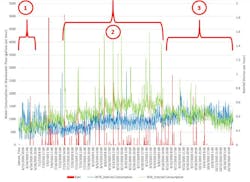Peeking Inside a Private Wastewater System
Typically, wastewater flow is not individually metered, and a utility’s rates are developed with the expectation that a portion of the water delivered to customers will be consumed on site and the rest will be returned as wastewater. In residential applications, consumption options may include drinking, irrigation, car washing, leaks, etc. For commercial or industrial applications, the process may include those in the residential category with the addition of uses included in manufacturing processes.
When the typical wastewater rates do not apply to a specific application, many utilities will install a separate wastewater meter at a site. This causes a challenge when comparing the hourly water meter readings to a single manually obtained monthly wastewater reading or when the wastewater readings are in a separate system. In addition, wastewater meters are not the same as water meters. Wastewater meters typically include only pulse and/or 4–20 mA outputs.
The City of Lakeland, Fla., has searched for an Advanced Metering Infrastructure (AMI) wastewater solution since we started our AMI water adventure in 2011. We recently partnered with Jesse Morris from 540 Technologies, and F.S. Brainard & Co. to pilot test a relatively new device, the Smart Meter-Master — Non-Encoder to Encoder Signal Converter (SMM). This device can be programmed to convert the pulse or 4–20 mA output signal from a wastewater meter into an encoder reading that will be accepted by an existing Meter Transceiver Unit (MXU) in the utility’s existing AMI system.
When we embarked upon this pilot project, we sought answers to the following questions:
- Will the SMM provide hourly readings to Lakeland’s existing AMI system?
- Will the SMM total the wastewater meter’s 4–20 mA output and track a total consumption over time?
- Will those readings allow Lakeland to compare the water delivered to the customer and the wastewater returned from the customer on a more granular scale, including hourly?
- Using the hourly readings, will the SMM enable Lakeland to determine when the customer discharged wastewater and sent it into the utility’s collection system?
To provide a more accurate picture of the customer’s AMI water cycle, we wanted to have the ability to analyze the following situations:
- Does a customer with a large private wastewater collection system have inflow and infiltration (I&I) issues? For example, a large mobile home park or apartment complex has a single, master meter that records all potable water delivered to the location. They also have a single wastewater meter recording all of the wastewater returned to the utility. Does stormwater or groundwater add to their wastewater flow through I&I into their private wastewater collection system? This will increase the amount of wastewater returned to the utility and add to the treatment volume and costs related to this customer.
- If a large industrial facility has a sampling station and a wastewater meter, can the utility determine when the industrial facility is discharging into the wastewater system? This will enable crews to schedule the sample collections around those discharge times to accurately reflect the chemicals and amounts and types of the various solids being discharged.
Preparing for More Data
On June 19, 2020, the City of Lakeland installed and activated the new SMM at a mobile home park with approximately 175 mobile homes. This location is an older park and was suspected of having I&I issues in its private wastewater collection system.
The initial installation and activation of the SMM was smooth and seamless. Connecting it to a typical MXU used on an AMI water meter was quick and easy. After activating the new installation, the MXU immediately started sending hourly readings into Lakeland’s AMI system.
Additionally, attaching the SMM to the wastewater flow meter did not impact any existing connections on that meter, so there will be no negative impact if the flow meter’s 4–20 mA output also needs to be connected to a SCADA system or other systems.
As part of the analysis process, Lakeland has a National Weather Service-approved rain gauge 0.9 miles from the mobile home park. This enabled us to record rainfall near the park’s location. The mobile home park also overlooks a lake. Both rainfall and the lake are potential sources of I&I into its private wastewater collection system. As we started to analyze the data, we discovered that the 2-inch water meter that serves the mobile home park was malfunctioning. The meter is a double dial turbine meter. The small side of this meter was failing to register accurately and was subsequently rebuilt on June 30, 2020. This is the area marked with a 1 in Fig. 1.
Fig. 1, area 2 indicates the time frame when the wastewater returned to the utility is larger than the amount of potable water provided to the customer. This clearly indicates I&I is being pulled into the private wastewater collection system. Because those spikes occur after a significant rainfall event, it indicates that this extra flow is related to stormwater runoff being sent into the private collection system. Likewise, the I&I volume gradually decreases after a heavy rain event.
Rehab on the private wastewater collection system was completed on September 10, 2020. The repairs on the customer’s private wastewater collection system included replacing many of its main collection lines and other necessary repairs discovered during the rehabilitation project. The flow after the repairs were completed (Area marked with a 3 on Fig. 1) clearly reflect a decrease in the wastewater flow related to the previous flow that included I&I.
With this pilot project, Lakeland was able to bring the wastewater hourly flow data into the same AMI application that receives data about hourly water consumption. Since a 4–20 mA wastewater meter is located near a 120-volt electric source and the SMM is also electric powered, there is no need to worry about maintaining a battery or alternate power source for this installation.
The volume of water received by the customer and the wastewater flow generated by the customer can be easily extracted and compared to provide a complete picture of the customer’s hourly data. This data can be used to identify trends and issues where the utility or customer may need to respond and reduce unnecessary costs associated with I&I and additional discharges included in a customer’s wastewater.
This analysis can be used to drive rate design for those larger customers that may generate unexpected amounts of wastewater.
One disadvantage of this functionality is that using current AMI systems, this analysis must be completed manually on a customer-by-customer basis. In our pilot project, the data was extracted out of the AMI applications and software like Microsoft Excel was used to compare water consumption to wastewater flow, create a graph and look for discrepancies or trends that need to be addressed. However, as utilities start to benefit from this comparison, we believe that software will evolve to another level and future versions will provide the ability to link a water and wastewater meter together and include this analysis as core functionality.
Finally, while the SMM has the flexibility to very adequately function in the scenarios outlined in this pilot project, there are additional costs to adding another device to the hourly AMI collection of the wastewater data and the analysis of that data. A utility should take those costs and resource commitments into consideration when committing to capture this data. In the mobile home park used in this pilot project, those costs were definitely worth the reward of reducing the amount of unnecessary groundwater being infiltrated into the private wastewater system that needed to be treated by the City of Lakeland. This ultimately reduced treatment costs for the utility. WW
About the Author: Raymond Hoppenworth is smart grid systems manager for the City of Lakeland, Fla., Water Utility.
About the Author
Raymond Hoppenworth
Raymond Hoppenworth is Smart Grid Systems Manager for the City of Lakeland (Fla.) Water Utility.


